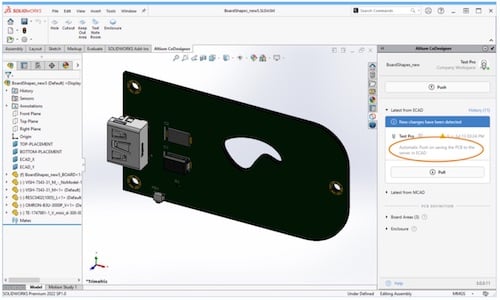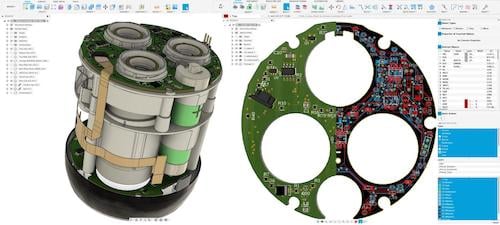For as long as designers have worked on mechanical products containing electronics, the CAD model or drawing contained a gray box. The box is where the electronics go, created by other engineers using other software. When it was common for design disciplines to work separately, the gray box was business as usual — it was document-based engineering at its finest.
In document-based engineering, collaboration is a sequential act. If the geometry changes and the gray box is moved or resized, or if the specific connectors change, you tell the other team. It’s not an efficient workflow, but it was the best way given the software tools available. Unfortunately, false starts, change orders, and unexpected incompatibilities were common.
Today, there is growing expectation for simultaneous collaboration. Product design is moving from documentation to modeling. The increased use of mechanical models — along with an increase in connectivity, thanks to cloud-enabled workflow — has led to an expectation of model-based design (MBD). The engineering process is now called mechatronics, for the uniting of mechanical and electronic. Putting a gray box in the model to symbolize a separate electronics design process is becoming an unacceptable practice, especially when the model is expected to be the foundation of a digital twin (and eventually a live digital twin).
How far down the path of simultaneous collaborative design a particular company has traveled is largely dependent on its size. Economies of scale for new engineering methods favor those with large R&D budgets. Simultaneous model-based collaborative design has become the norm for the very largest engineering companies — the aerospace and automotive behemoths. From there, it trickles down to the midsize manufacturers and finally the smallest engineering groups, as the CAD tools popular at each level mature. It is an ongoing process, and will continue for the next several years.
PCB Studio is a free add-on for Onshape, PTC’s cloud-based MCAD platform. Image source: PTC.
The process of bringing advanced software utility to a larger market is known as democratization. The first example of model-based design was the release of Dassault Systemès CATIA V6 and its cloud-enabled collaborative approach to design. The primary competitors to Dassault’s CATIA (PTC Creo and Siemens NX) quickly found ways within their own technology to advance in a similar direction. Now the democratization of Model Based Design has reached the level of Autodesk and Dassault’s SOLIDWORKS division, the two largest providers of CAD modeling tools to the wider engineering market.

Altium CoDesigner for electronic design can appear in a Dassault Systemès SOLIDWORKS project. Image source: Altium. Click image to enlarge.
MCAD/ECAD Integration
The process of integrating MCAD with ECAD is on a similar path as the development of model-based design.
Creating mechanical design software (MCAD) and electronics design software (ECAD) are two very separate endeavors. The largest names in electronics CAD are not the same companies that offer mechanical CAD. The software tools have been largely incompatible with each other, leading to the gray box as an industry standard.
Product development is adapting to the challenge of unified mechatronic design in two ways, cooperation or acquisition.

Autodesk Fusion 360 is a cloud-enabled product design platform that has both MCAD and ECAD tools. Image source: Autodesk. Click image to enlarge.
Cooperation primarily means several companies agree on standards-based processes. Sometimes cooperation takes the form of two companies striking a deal to share proprietary technology with each other. Acquisition takes this a step further, allowing one company to bring all the required technologies under one roof, uniting it with proprietary processes.
The following list provides an overview of what leading CAD vendors are doing to integrate MCAD and ECAD into a unified development workflow. The list is not exhaustive.
Cadence Allegro and Dassault Systèmes 3DEXPERIENCE: A technology sharing agreement is creating a platform for electromechanical systems modeling, design, simulation and product lifecycle management.
Altium Designer and Altium 360 = Altium 365: Software collaboration tools to unite MCAD/ECAD through intentional compatibility with major MCAD/ECAD formats.
Autodesk Fusion 360: A unified cloud-aware engineering environment with MCAD and ECAD tools that bypass the need for file translation.
Siemens Xpedition: A platform for using multiple software products to manage concurrent mechatronic engineering.
PTC Creo ECX: Short for ECAD Collaboration Extension, ECX is software for integrating ECAD data created by products from Altium, Cadence, and Mentor (now part of Siemens).
Onshape PCB Studio: A free add-on that imports ECAD file data into an Onshape MCAD project. It supports IDF, IDX, and Eagle formats.

Searching for more information about Product Design & Manufacturing?
Click here!





Share This Post